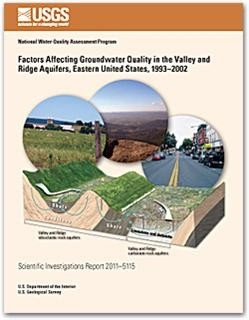
Product Details
- Product Number
- 296890
- Series
- SIR-2011-5115
- Scale
- NO SCALE
- Alternate ID
- SIR-2011-5115
- ISBN
- 978-1-4113-3216-4
- Authors
- BRUCE D LINDSEY
- Version Date
- 01/01/2011
- Countries
- USA
- Media
- Paper
- Format
- Bound
Additional Details
- Description
- Abstract Chemical and microbiological analyses of water from 230 wells and 35 springs in the Valley and Ridge Physiographic Province, sampled between 1993 and 2002, indicated that bedrock type (carbonate or siliciclastic rock) and land use were dominant factors influencing groundwater quality across a region extending from northwestern Georgia to New Jersey. The analyses included naturally occurring compounds (major mineral ions and radon) and anthropogenic contaminants [pesticides and volatile organic compounds (VOCs)], and contaminants, such as nitrate and bacteria, which commonly increase as a result of human activities. Natural factors, such as topographic position and the mineral composition of underlying geology, act to produce basic physical and geochemical conditions in groundwater that are reflected in physical properties, such as pH, temperature, specific conductance, and alkalinity, and in chemical concentrations of dissolved oxygen, radon, and major mineral ions. Anthropogenic contaminants were most commonly found in water from wells and springs in carbonate-rock aquifers. Nitrate concentrations exceeded U.S. Environmental Protection Agency maximum contaminant levels in 12 percent of samples, most of which were from carbonate-rock aquifers. Escherichia coli (E. coli), pesticide, and VOC detection frequencies were significantly higher in samples from sites in carbonate-rock aquifers. Naturally occurring elements, such as radon, iron, and manganese, were found in higher concentrations in siliciclastic-rock aquifers. Radon levels exceeded the proposed maximum contaminant level of 300 picocuries per liter in 74 percent of the samples, which were evenly distributed between carbonate- and siliciclastic-rock aquifers. The land use in areas surrounding wells and springs was another significant explanatory variable for the occurrence of anthropogenic compounds. Nitrate and pesticide concentrations were highest in samples collected from sites in agricultural areas and lowest in samples collected from sites in undeveloped areas. Volatile organic compounds were detected most frequently and in highest concentrations in samples from sites in urban areas, and least frequently in agricultural and undeveloped areas. No volatile organic compound concentrations and concentrations from only one pesticide, dieldrin, exceeded human-health benchmarks.
- Survey Date
- 2011
- Print Date
- 2011
- Height In Inches
- 11.000
- Length In Inches
- 8.500
- Two Sided
- Yes
- Pieces
- 1
- Languages
- English
Related Items




